Comparative Analysis of Organization Types: A Detailed Report
VerifiedAdded on 2021/01/11
|16
|6047
|36
Report
AI Summary
This report provides a comprehensive analysis of various organization types, including public, private, and voluntary sectors. It begins by defining organizations and classifying them based on size, scope, legal structure, and stakeholder types. The report delves into the characteristics of each sector, examining their missions, visions, and strategies. The public sector analysis includes examples like the HK Custom and Immigration Department, exploring advantages such as protection of public interest and easier planning, alongside disadvantages like difficulty in management and political influence. The private sector section covers sole traders, partnerships, private limited companies, and public limited companies, outlining their structures, advantages, and disadvantages. The voluntary sector, focusing on nonprofit organizations, is also examined. The report concludes by discussing how different organization types can expand into the international business environment through methods like franchising, licensing, and joint ventures. The Civil Aviation Department (CAD) of Hong Kong is presented as a case study within the public sector context.
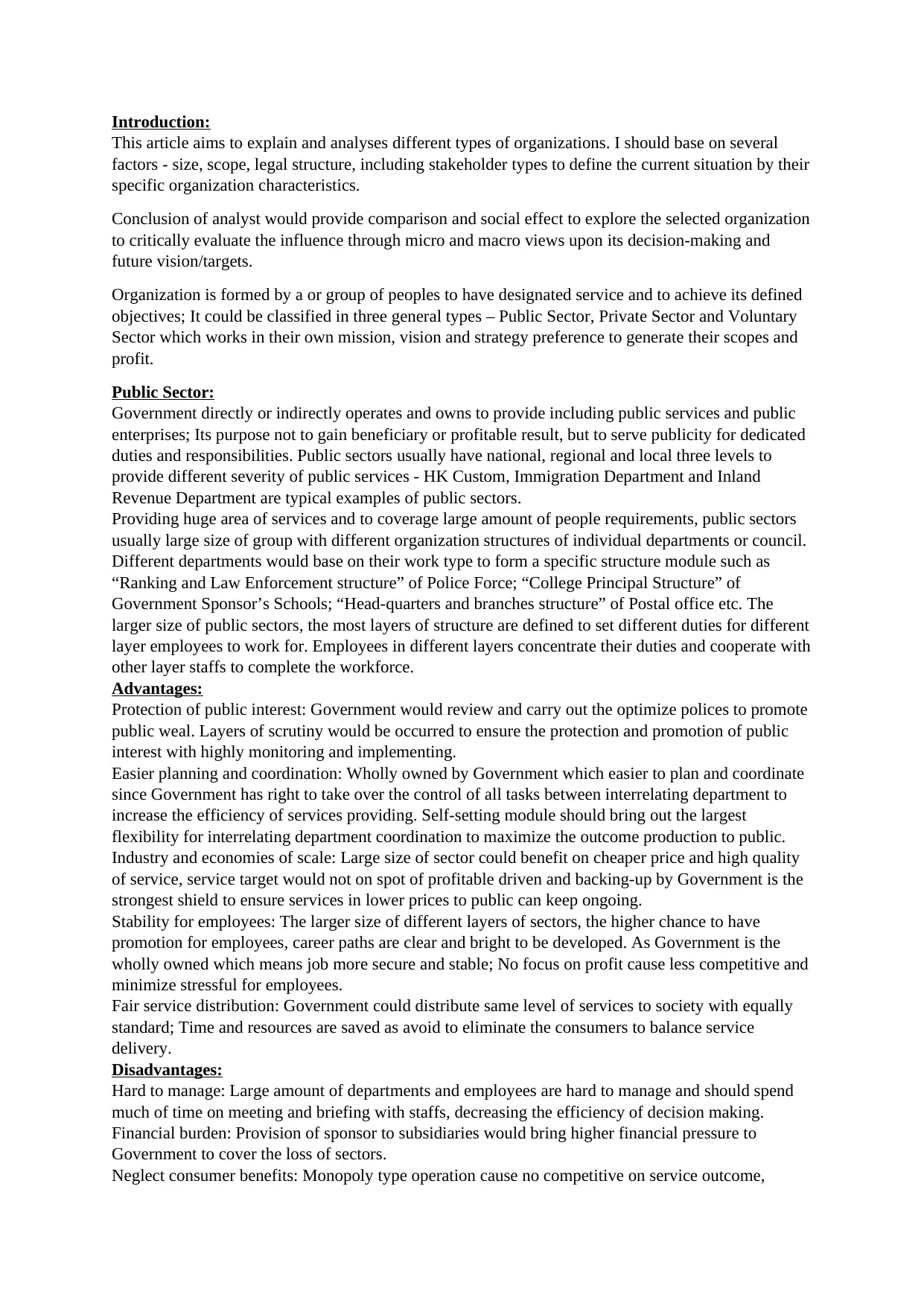
Introduction:
This article aims to explain and analyses different types of organizations. I should base on several
factors - size, scope, legal structure, including stakeholder types to define the current situation by their
specific organization characteristics.
Conclusion of analyst would provide comparison and social effect to explore the selected organization
to critically evaluate the influence through micro and macro views upon its decision-making and
future vision/targets.
Organization is formed by a or group of peoples to have designated service and to achieve its defined
objectives; It could be classified in three general types – Public Sector, Private Sector and Voluntary
Sector which works in their own mission, vision and strategy preference to generate their scopes and
profit.
Public Sector:
Government directly or indirectly operates and owns to provide including public services and public
enterprises; Its purpose not to gain beneficiary or profitable result, but to serve publicity for dedicated
duties and responsibilities. Public sectors usually have national, regional and local three levels to
provide different severity of public services - HK Custom, Immigration Department and Inland
Revenue Department are typical examples of public sectors.
Providing huge area of services and to coverage large amount of people requirements, public sectors
usually large size of group with different organization structures of individual departments or council.
Different departments would base on their work type to form a specific structure module such as
“Ranking and Law Enforcement structure” of Police Force; “College Principal Structure” of
Government Sponsor’s Schools; “Head-quarters and branches structure” of Postal office etc. The
larger size of public sectors, the most layers of structure are defined to set different duties for different
layer employees to work for. Employees in different layers concentrate their duties and cooperate with
other layer staffs to complete the workforce.
Advantages:
Protection of public interest: Government would review and carry out the optimize polices to promote
public weal. Layers of scrutiny would be occurred to ensure the protection and promotion of public
interest with highly monitoring and implementing.
Easier planning and coordination: Wholly owned by Government which easier to plan and coordinate
since Government has right to take over the control of all tasks between interrelating department to
increase the efficiency of services providing. Self-setting module should bring out the largest
flexibility for interrelating department coordination to maximize the outcome production to public.
Industry and economies of scale: Large size of sector could benefit on cheaper price and high quality
of service, service target would not on spot of profitable driven and backing-up by Government is the
strongest shield to ensure services in lower prices to public can keep ongoing.
Stability for employees: The larger size of different layers of sectors, the higher chance to have
promotion for employees, career paths are clear and bright to be developed. As Government is the
wholly owned which means job more secure and stable; No focus on profit cause less competitive and
minimize stressful for employees.
Fair service distribution: Government could distribute same level of services to society with equally
standard; Time and resources are saved as avoid to eliminate the consumers to balance service
delivery.
Disadvantages:
Hard to manage: Large amount of departments and employees are hard to manage and should spend
much of time on meeting and briefing with staffs, decreasing the efficiency of decision making.
Financial burden: Provision of sponsor to subsidiaries would bring higher financial pressure to
Government to cover the loss of sectors.
Neglect consumer benefits: Monopoly type operation cause no competitive on service outcome,
This article aims to explain and analyses different types of organizations. I should base on several
factors - size, scope, legal structure, including stakeholder types to define the current situation by their
specific organization characteristics.
Conclusion of analyst would provide comparison and social effect to explore the selected organization
to critically evaluate the influence through micro and macro views upon its decision-making and
future vision/targets.
Organization is formed by a or group of peoples to have designated service and to achieve its defined
objectives; It could be classified in three general types – Public Sector, Private Sector and Voluntary
Sector which works in their own mission, vision and strategy preference to generate their scopes and
profit.
Public Sector:
Government directly or indirectly operates and owns to provide including public services and public
enterprises; Its purpose not to gain beneficiary or profitable result, but to serve publicity for dedicated
duties and responsibilities. Public sectors usually have national, regional and local three levels to
provide different severity of public services - HK Custom, Immigration Department and Inland
Revenue Department are typical examples of public sectors.
Providing huge area of services and to coverage large amount of people requirements, public sectors
usually large size of group with different organization structures of individual departments or council.
Different departments would base on their work type to form a specific structure module such as
“Ranking and Law Enforcement structure” of Police Force; “College Principal Structure” of
Government Sponsor’s Schools; “Head-quarters and branches structure” of Postal office etc. The
larger size of public sectors, the most layers of structure are defined to set different duties for different
layer employees to work for. Employees in different layers concentrate their duties and cooperate with
other layer staffs to complete the workforce.
Advantages:
Protection of public interest: Government would review and carry out the optimize polices to promote
public weal. Layers of scrutiny would be occurred to ensure the protection and promotion of public
interest with highly monitoring and implementing.
Easier planning and coordination: Wholly owned by Government which easier to plan and coordinate
since Government has right to take over the control of all tasks between interrelating department to
increase the efficiency of services providing. Self-setting module should bring out the largest
flexibility for interrelating department coordination to maximize the outcome production to public.
Industry and economies of scale: Large size of sector could benefit on cheaper price and high quality
of service, service target would not on spot of profitable driven and backing-up by Government is the
strongest shield to ensure services in lower prices to public can keep ongoing.
Stability for employees: The larger size of different layers of sectors, the higher chance to have
promotion for employees, career paths are clear and bright to be developed. As Government is the
wholly owned which means job more secure and stable; No focus on profit cause less competitive and
minimize stressful for employees.
Fair service distribution: Government could distribute same level of services to society with equally
standard; Time and resources are saved as avoid to eliminate the consumers to balance service
delivery.
Disadvantages:
Hard to manage: Large amount of departments and employees are hard to manage and should spend
much of time on meeting and briefing with staffs, decreasing the efficiency of decision making.
Financial burden: Provision of sponsor to subsidiaries would bring higher financial pressure to
Government to cover the loss of sectors.
Neglect consumer benefits: Monopoly type operation cause no competitive on service outcome,
Paraphrase This Document
Need a fresh take? Get an instant paraphrase of this document with our AI Paraphraser
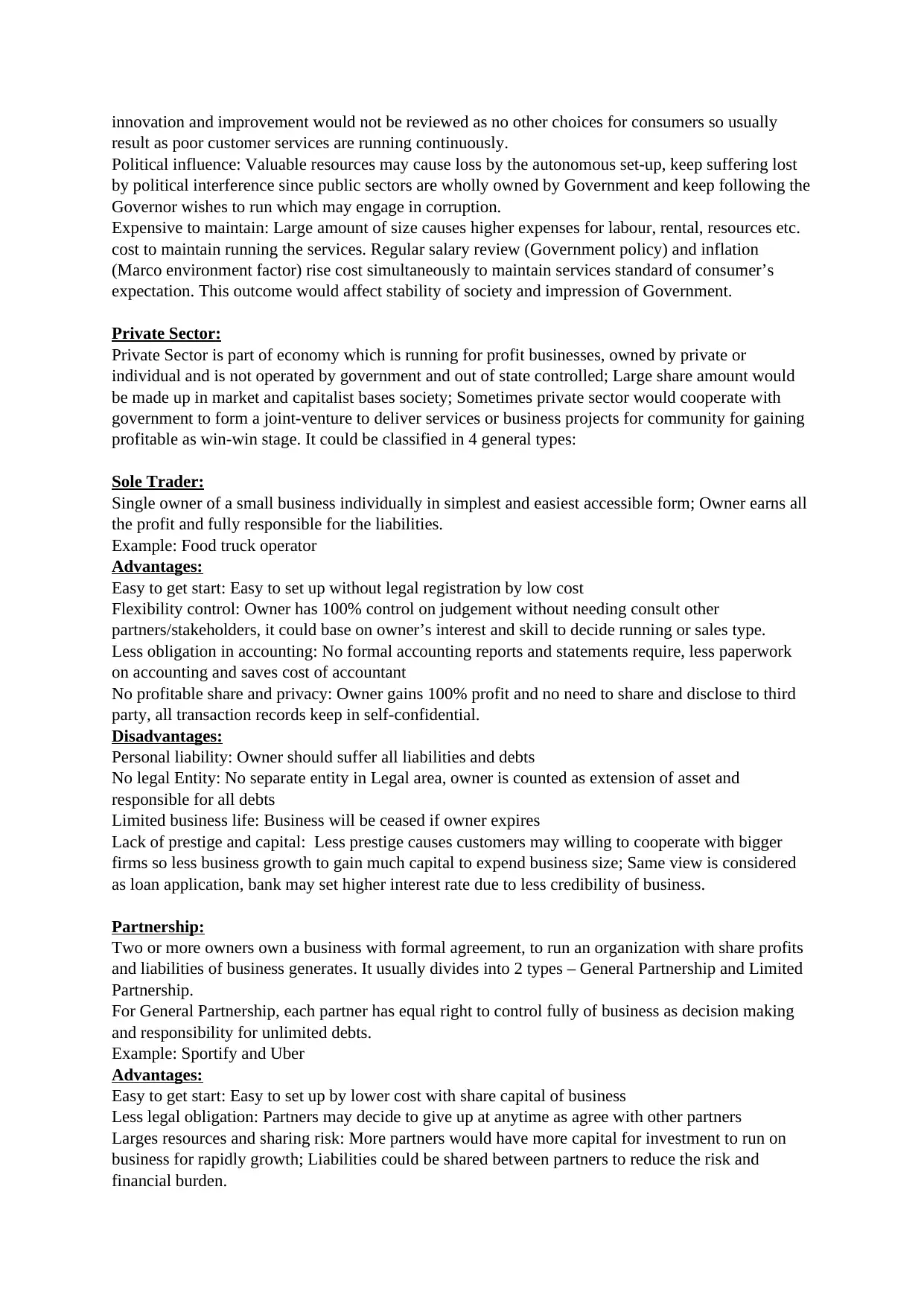
innovation and improvement would not be reviewed as no other choices for consumers so usually
result as poor customer services are running continuously.
Political influence: Valuable resources may cause loss by the autonomous set-up, keep suffering lost
by political interference since public sectors are wholly owned by Government and keep following the
Governor wishes to run which may engage in corruption.
Expensive to maintain: Large amount of size causes higher expenses for labour, rental, resources etc.
cost to maintain running the services. Regular salary review (Government policy) and inflation
(Marco environment factor) rise cost simultaneously to maintain services standard of consumer’s
expectation. This outcome would affect stability of society and impression of Government.
Private Sector:
Private Sector is part of economy which is running for profit businesses, owned by private or
individual and is not operated by government and out of state controlled; Large share amount would
be made up in market and capitalist bases society; Sometimes private sector would cooperate with
government to form a joint-venture to deliver services or business projects for community for gaining
profitable as win-win stage. It could be classified in 4 general types:
Sole Trader:
Single owner of a small business individually in simplest and easiest accessible form; Owner earns all
the profit and fully responsible for the liabilities.
Example: Food truck operator
Advantages:
Easy to get start: Easy to set up without legal registration by low cost
Flexibility control: Owner has 100% control on judgement without needing consult other
partners/stakeholders, it could base on owner’s interest and skill to decide running or sales type.
Less obligation in accounting: No formal accounting reports and statements require, less paperwork
on accounting and saves cost of accountant
No profitable share and privacy: Owner gains 100% profit and no need to share and disclose to third
party, all transaction records keep in self-confidential.
Disadvantages:
Personal liability: Owner should suffer all liabilities and debts
No legal Entity: No separate entity in Legal area, owner is counted as extension of asset and
responsible for all debts
Limited business life: Business will be ceased if owner expires
Lack of prestige and capital: Less prestige causes customers may willing to cooperate with bigger
firms so less business growth to gain much capital to expend business size; Same view is considered
as loan application, bank may set higher interest rate due to less credibility of business.
Partnership:
Two or more owners own a business with formal agreement, to run an organization with share profits
and liabilities of business generates. It usually divides into 2 types – General Partnership and Limited
Partnership.
For General Partnership, each partner has equal right to control fully of business as decision making
and responsibility for unlimited debts.
Example: Sportify and Uber
Advantages:
Easy to get start: Easy to set up by lower cost with share capital of business
Less legal obligation: Partners may decide to give up at anytime as agree with other partners
Larges resources and sharing risk: More partners would have more capital for investment to run on
business for rapidly growth; Liabilities could be shared between partners to reduce the risk and
financial burden.
result as poor customer services are running continuously.
Political influence: Valuable resources may cause loss by the autonomous set-up, keep suffering lost
by political interference since public sectors are wholly owned by Government and keep following the
Governor wishes to run which may engage in corruption.
Expensive to maintain: Large amount of size causes higher expenses for labour, rental, resources etc.
cost to maintain running the services. Regular salary review (Government policy) and inflation
(Marco environment factor) rise cost simultaneously to maintain services standard of consumer’s
expectation. This outcome would affect stability of society and impression of Government.
Private Sector:
Private Sector is part of economy which is running for profit businesses, owned by private or
individual and is not operated by government and out of state controlled; Large share amount would
be made up in market and capitalist bases society; Sometimes private sector would cooperate with
government to form a joint-venture to deliver services or business projects for community for gaining
profitable as win-win stage. It could be classified in 4 general types:
Sole Trader:
Single owner of a small business individually in simplest and easiest accessible form; Owner earns all
the profit and fully responsible for the liabilities.
Example: Food truck operator
Advantages:
Easy to get start: Easy to set up without legal registration by low cost
Flexibility control: Owner has 100% control on judgement without needing consult other
partners/stakeholders, it could base on owner’s interest and skill to decide running or sales type.
Less obligation in accounting: No formal accounting reports and statements require, less paperwork
on accounting and saves cost of accountant
No profitable share and privacy: Owner gains 100% profit and no need to share and disclose to third
party, all transaction records keep in self-confidential.
Disadvantages:
Personal liability: Owner should suffer all liabilities and debts
No legal Entity: No separate entity in Legal area, owner is counted as extension of asset and
responsible for all debts
Limited business life: Business will be ceased if owner expires
Lack of prestige and capital: Less prestige causes customers may willing to cooperate with bigger
firms so less business growth to gain much capital to expend business size; Same view is considered
as loan application, bank may set higher interest rate due to less credibility of business.
Partnership:
Two or more owners own a business with formal agreement, to run an organization with share profits
and liabilities of business generates. It usually divides into 2 types – General Partnership and Limited
Partnership.
For General Partnership, each partner has equal right to control fully of business as decision making
and responsibility for unlimited debts.
Example: Sportify and Uber
Advantages:
Easy to get start: Easy to set up by lower cost with share capital of business
Less legal obligation: Partners may decide to give up at anytime as agree with other partners
Larges resources and sharing risk: More partners would have more capital for investment to run on
business for rapidly growth; Liabilities could be shared between partners to reduce the risk and
financial burden.
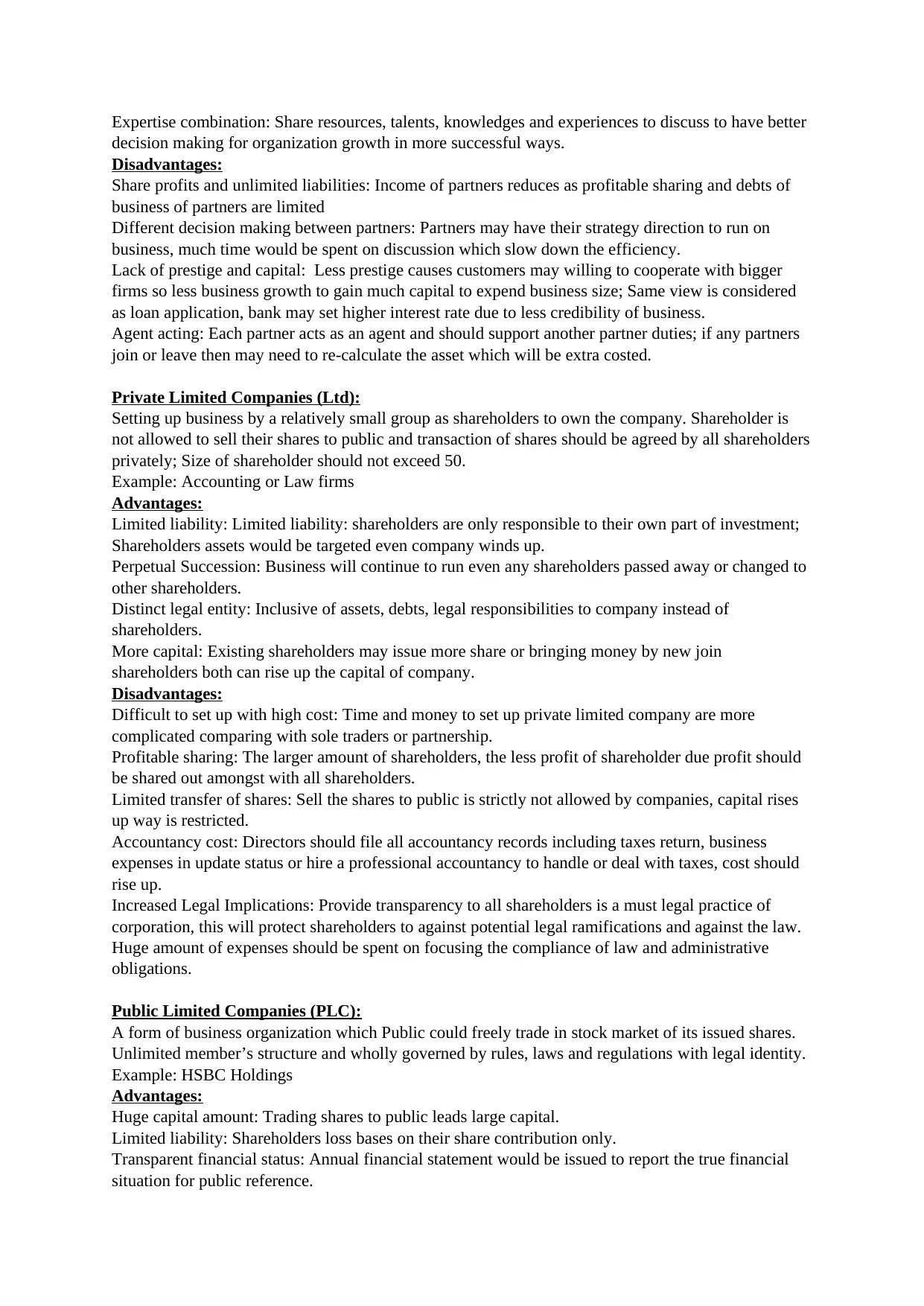
Expertise combination: Share resources, talents, knowledges and experiences to discuss to have better
decision making for organization growth in more successful ways.
Disadvantages:
Share profits and unlimited liabilities: Income of partners reduces as profitable sharing and debts of
business of partners are limited
Different decision making between partners: Partners may have their strategy direction to run on
business, much time would be spent on discussion which slow down the efficiency.
Lack of prestige and capital: Less prestige causes customers may willing to cooperate with bigger
firms so less business growth to gain much capital to expend business size; Same view is considered
as loan application, bank may set higher interest rate due to less credibility of business.
Agent acting: Each partner acts as an agent and should support another partner duties; if any partners
join or leave then may need to re-calculate the asset which will be extra costed.
Private Limited Companies (Ltd):
Setting up business by a relatively small group as shareholders to own the company. Shareholder is
not allowed to sell their shares to public and transaction of shares should be agreed by all shareholders
privately; Size of shareholder should not exceed 50.
Example: Accounting or Law firms
Advantages:
Limited liability: Limited liability: shareholders are only responsible to their own part of investment;
Shareholders assets would be targeted even company winds up.
Perpetual Succession: Business will continue to run even any shareholders passed away or changed to
other shareholders.
Distinct legal entity: Inclusive of assets, debts, legal responsibilities to company instead of
shareholders.
More capital: Existing shareholders may issue more share or bringing money by new join
shareholders both can rise up the capital of company.
Disadvantages:
Difficult to set up with high cost: Time and money to set up private limited company are more
complicated comparing with sole traders or partnership.
Profitable sharing: The larger amount of shareholders, the less profit of shareholder due profit should
be shared out amongst with all shareholders.
Limited transfer of shares: Sell the shares to public is strictly not allowed by companies, capital rises
up way is restricted.
Accountancy cost: Directors should file all accountancy records including taxes return, business
expenses in update status or hire a professional accountancy to handle or deal with taxes, cost should
rise up.
Increased Legal Implications: Provide transparency to all shareholders is a must legal practice of
corporation, this will protect shareholders to against potential legal ramifications and against the law.
Huge amount of expenses should be spent on focusing the compliance of law and administrative
obligations.
Public Limited Companies (PLC):
A form of business organization which Public could freely trade in stock market of its issued shares.
Unlimited member’s structure and wholly governed by rules, laws and regulations with legal identity.
Example: HSBC Holdings
Advantages:
Huge capital amount: Trading shares to public leads large capital.
Limited liability: Shareholders loss bases on their share contribution only.
Transparent financial status: Annual financial statement would be issued to report the true financial
situation for public reference.
decision making for organization growth in more successful ways.
Disadvantages:
Share profits and unlimited liabilities: Income of partners reduces as profitable sharing and debts of
business of partners are limited
Different decision making between partners: Partners may have their strategy direction to run on
business, much time would be spent on discussion which slow down the efficiency.
Lack of prestige and capital: Less prestige causes customers may willing to cooperate with bigger
firms so less business growth to gain much capital to expend business size; Same view is considered
as loan application, bank may set higher interest rate due to less credibility of business.
Agent acting: Each partner acts as an agent and should support another partner duties; if any partners
join or leave then may need to re-calculate the asset which will be extra costed.
Private Limited Companies (Ltd):
Setting up business by a relatively small group as shareholders to own the company. Shareholder is
not allowed to sell their shares to public and transaction of shares should be agreed by all shareholders
privately; Size of shareholder should not exceed 50.
Example: Accounting or Law firms
Advantages:
Limited liability: Limited liability: shareholders are only responsible to their own part of investment;
Shareholders assets would be targeted even company winds up.
Perpetual Succession: Business will continue to run even any shareholders passed away or changed to
other shareholders.
Distinct legal entity: Inclusive of assets, debts, legal responsibilities to company instead of
shareholders.
More capital: Existing shareholders may issue more share or bringing money by new join
shareholders both can rise up the capital of company.
Disadvantages:
Difficult to set up with high cost: Time and money to set up private limited company are more
complicated comparing with sole traders or partnership.
Profitable sharing: The larger amount of shareholders, the less profit of shareholder due profit should
be shared out amongst with all shareholders.
Limited transfer of shares: Sell the shares to public is strictly not allowed by companies, capital rises
up way is restricted.
Accountancy cost: Directors should file all accountancy records including taxes return, business
expenses in update status or hire a professional accountancy to handle or deal with taxes, cost should
rise up.
Increased Legal Implications: Provide transparency to all shareholders is a must legal practice of
corporation, this will protect shareholders to against potential legal ramifications and against the law.
Huge amount of expenses should be spent on focusing the compliance of law and administrative
obligations.
Public Limited Companies (PLC):
A form of business organization which Public could freely trade in stock market of its issued shares.
Unlimited member’s structure and wholly governed by rules, laws and regulations with legal identity.
Example: HSBC Holdings
Advantages:
Huge capital amount: Trading shares to public leads large capital.
Limited liability: Shareholders loss bases on their share contribution only.
Transparent financial status: Annual financial statement would be issued to report the true financial
situation for public reference.
⊘ This is a preview!⊘
Do you want full access?
Subscribe today to unlock all pages.

Trusted by 1+ million students worldwide
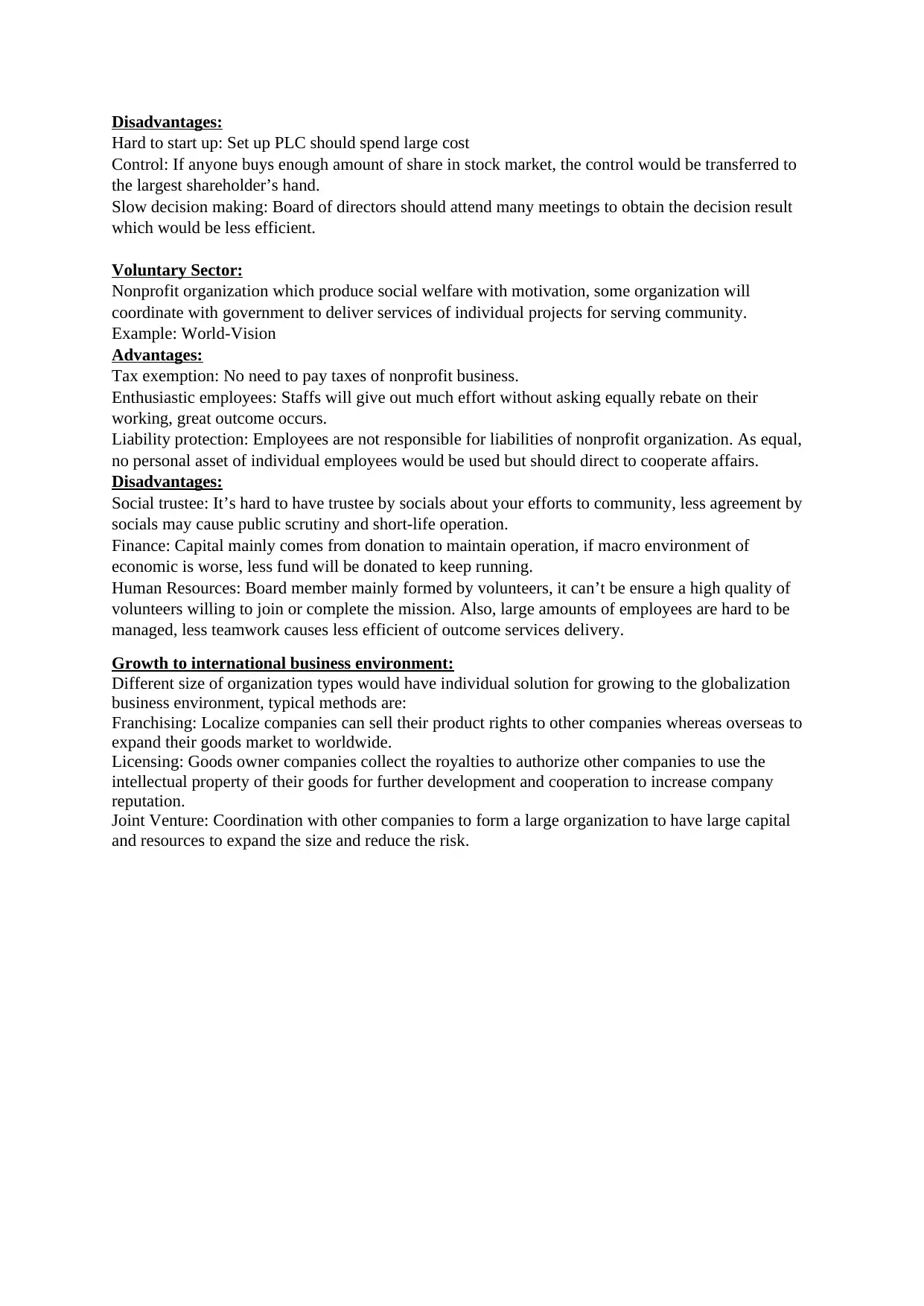
Disadvantages:
Hard to start up: Set up PLC should spend large cost
Control: If anyone buys enough amount of share in stock market, the control would be transferred to
the largest shareholder’s hand.
Slow decision making: Board of directors should attend many meetings to obtain the decision result
which would be less efficient.
Voluntary Sector:
Nonprofit organization which produce social welfare with motivation, some organization will
coordinate with government to deliver services of individual projects for serving community.
Example: World-Vision
Advantages:
Tax exemption: No need to pay taxes of nonprofit business.
Enthusiastic employees: Staffs will give out much effort without asking equally rebate on their
working, great outcome occurs.
Liability protection: Employees are not responsible for liabilities of nonprofit organization. As equal,
no personal asset of individual employees would be used but should direct to cooperate affairs.
Disadvantages:
Social trustee: It’s hard to have trustee by socials about your efforts to community, less agreement by
socials may cause public scrutiny and short-life operation.
Finance: Capital mainly comes from donation to maintain operation, if macro environment of
economic is worse, less fund will be donated to keep running.
Human Resources: Board member mainly formed by volunteers, it can’t be ensure a high quality of
volunteers willing to join or complete the mission. Also, large amounts of employees are hard to be
managed, less teamwork causes less efficient of outcome services delivery.
Growth to international business environment:
Different size of organization types would have individual solution for growing to the globalization
business environment, typical methods are:
Franchising: Localize companies can sell their product rights to other companies whereas overseas to
expand their goods market to worldwide.
Licensing: Goods owner companies collect the royalties to authorize other companies to use the
intellectual property of their goods for further development and cooperation to increase company
reputation.
Joint Venture: Coordination with other companies to form a large organization to have large capital
and resources to expand the size and reduce the risk.
Hard to start up: Set up PLC should spend large cost
Control: If anyone buys enough amount of share in stock market, the control would be transferred to
the largest shareholder’s hand.
Slow decision making: Board of directors should attend many meetings to obtain the decision result
which would be less efficient.
Voluntary Sector:
Nonprofit organization which produce social welfare with motivation, some organization will
coordinate with government to deliver services of individual projects for serving community.
Example: World-Vision
Advantages:
Tax exemption: No need to pay taxes of nonprofit business.
Enthusiastic employees: Staffs will give out much effort without asking equally rebate on their
working, great outcome occurs.
Liability protection: Employees are not responsible for liabilities of nonprofit organization. As equal,
no personal asset of individual employees would be used but should direct to cooperate affairs.
Disadvantages:
Social trustee: It’s hard to have trustee by socials about your efforts to community, less agreement by
socials may cause public scrutiny and short-life operation.
Finance: Capital mainly comes from donation to maintain operation, if macro environment of
economic is worse, less fund will be donated to keep running.
Human Resources: Board member mainly formed by volunteers, it can’t be ensure a high quality of
volunteers willing to join or complete the mission. Also, large amounts of employees are hard to be
managed, less teamwork causes less efficient of outcome services delivery.
Growth to international business environment:
Different size of organization types would have individual solution for growing to the globalization
business environment, typical methods are:
Franchising: Localize companies can sell their product rights to other companies whereas overseas to
expand their goods market to worldwide.
Licensing: Goods owner companies collect the royalties to authorize other companies to use the
intellectual property of their goods for further development and cooperation to increase company
reputation.
Joint Venture: Coordination with other companies to form a large organization to have large capital
and resources to expand the size and reduce the risk.
Paraphrase This Document
Need a fresh take? Get an instant paraphrase of this document with our AI Paraphraser
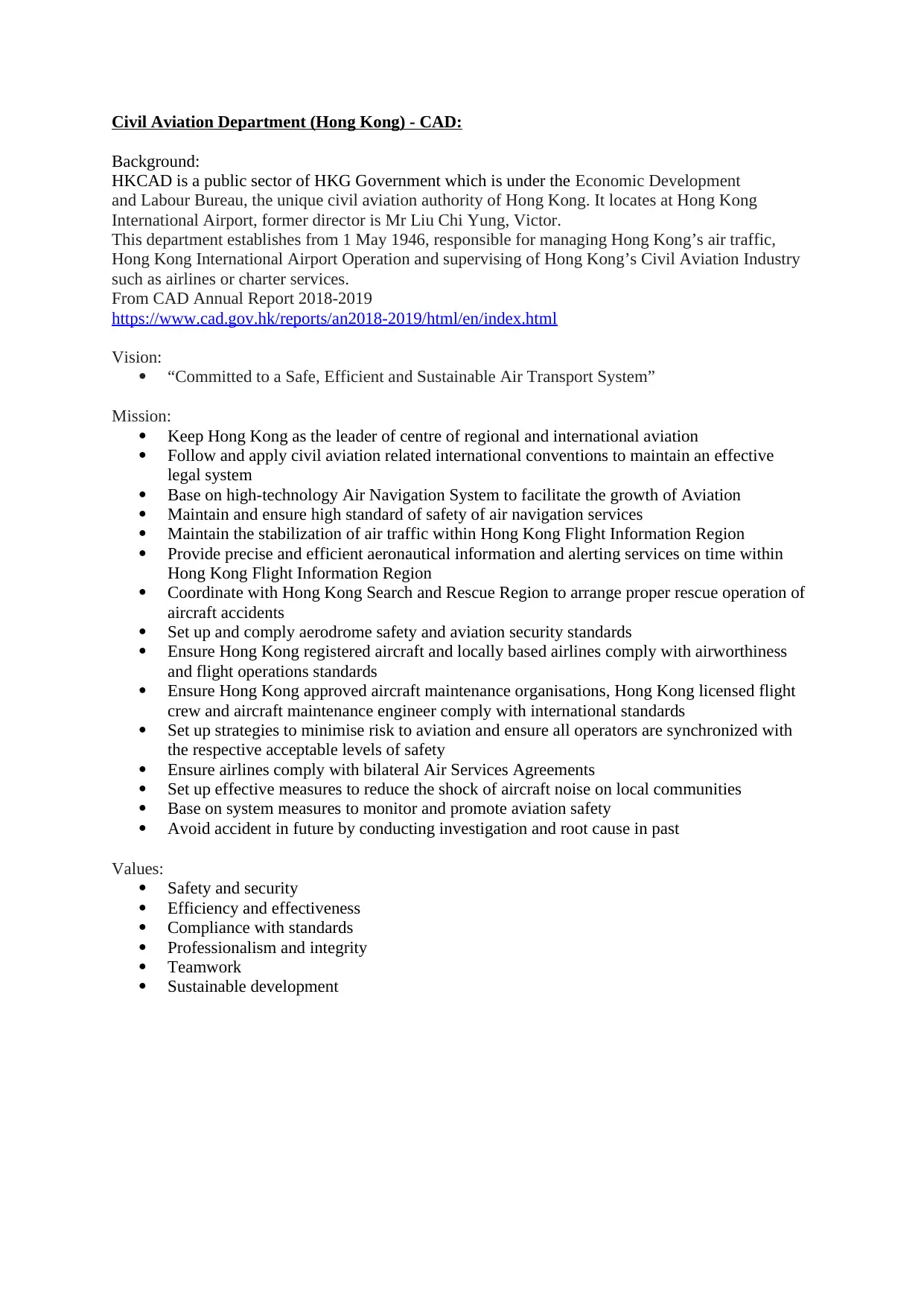
Civil Aviation Department (Hong Kong) - CAD:
Background:
HKCAD is a public sector of HKG Government which is under the Economic Development
and Labour Bureau, the unique civil aviation authority of Hong Kong. It locates at Hong Kong
International Airport, former director is Mr Liu Chi Yung, Victor.
This department establishes from 1 May 1946, responsible for managing Hong Kong’s air traffic,
Hong Kong International Airport Operation and supervising of Hong Kong’s Civil Aviation Industry
such as airlines or charter services.
From CAD Annual Report 2018-2019
https://www.cad.gov.hk/reports/an2018-2019/html/en/index.html
Vision:
“Committed to a Safe, Efficient and Sustainable Air Transport System”
Mission:
Keep Hong Kong as the leader of centre of regional and international aviation
Follow and apply civil aviation related international conventions to maintain an effective
legal system
Base on high-technology Air Navigation System to facilitate the growth of Aviation
Maintain and ensure high standard of safety of air navigation services
Maintain the stabilization of air traffic within Hong Kong Flight Information Region
Provide precise and efficient aeronautical information and alerting services on time within
Hong Kong Flight Information Region
Coordinate with Hong Kong Search and Rescue Region to arrange proper rescue operation of
aircraft accidents
Set up and comply aerodrome safety and aviation security standards
Ensure Hong Kong registered aircraft and locally based airlines comply with airworthiness
and flight operations standards
Ensure Hong Kong approved aircraft maintenance organisations, Hong Kong licensed flight
crew and aircraft maintenance engineer comply with international standards
Set up strategies to minimise risk to aviation and ensure all operators are synchronized with
the respective acceptable levels of safety
Ensure airlines comply with bilateral Air Services Agreements
Set up effective measures to reduce the shock of aircraft noise on local communities
Base on system measures to monitor and promote aviation safety
Avoid accident in future by conducting investigation and root cause in past
Values:
Safety and security
Efficiency and effectiveness
Compliance with standards
Professionalism and integrity
Teamwork
Sustainable development
Background:
HKCAD is a public sector of HKG Government which is under the Economic Development
and Labour Bureau, the unique civil aviation authority of Hong Kong. It locates at Hong Kong
International Airport, former director is Mr Liu Chi Yung, Victor.
This department establishes from 1 May 1946, responsible for managing Hong Kong’s air traffic,
Hong Kong International Airport Operation and supervising of Hong Kong’s Civil Aviation Industry
such as airlines or charter services.
From CAD Annual Report 2018-2019
https://www.cad.gov.hk/reports/an2018-2019/html/en/index.html
Vision:
“Committed to a Safe, Efficient and Sustainable Air Transport System”
Mission:
Keep Hong Kong as the leader of centre of regional and international aviation
Follow and apply civil aviation related international conventions to maintain an effective
legal system
Base on high-technology Air Navigation System to facilitate the growth of Aviation
Maintain and ensure high standard of safety of air navigation services
Maintain the stabilization of air traffic within Hong Kong Flight Information Region
Provide precise and efficient aeronautical information and alerting services on time within
Hong Kong Flight Information Region
Coordinate with Hong Kong Search and Rescue Region to arrange proper rescue operation of
aircraft accidents
Set up and comply aerodrome safety and aviation security standards
Ensure Hong Kong registered aircraft and locally based airlines comply with airworthiness
and flight operations standards
Ensure Hong Kong approved aircraft maintenance organisations, Hong Kong licensed flight
crew and aircraft maintenance engineer comply with international standards
Set up strategies to minimise risk to aviation and ensure all operators are synchronized with
the respective acceptable levels of safety
Ensure airlines comply with bilateral Air Services Agreements
Set up effective measures to reduce the shock of aircraft noise on local communities
Base on system measures to monitor and promote aviation safety
Avoid accident in future by conducting investigation and root cause in past
Values:
Safety and security
Efficiency and effectiveness
Compliance with standards
Professionalism and integrity
Teamwork
Sustainable development
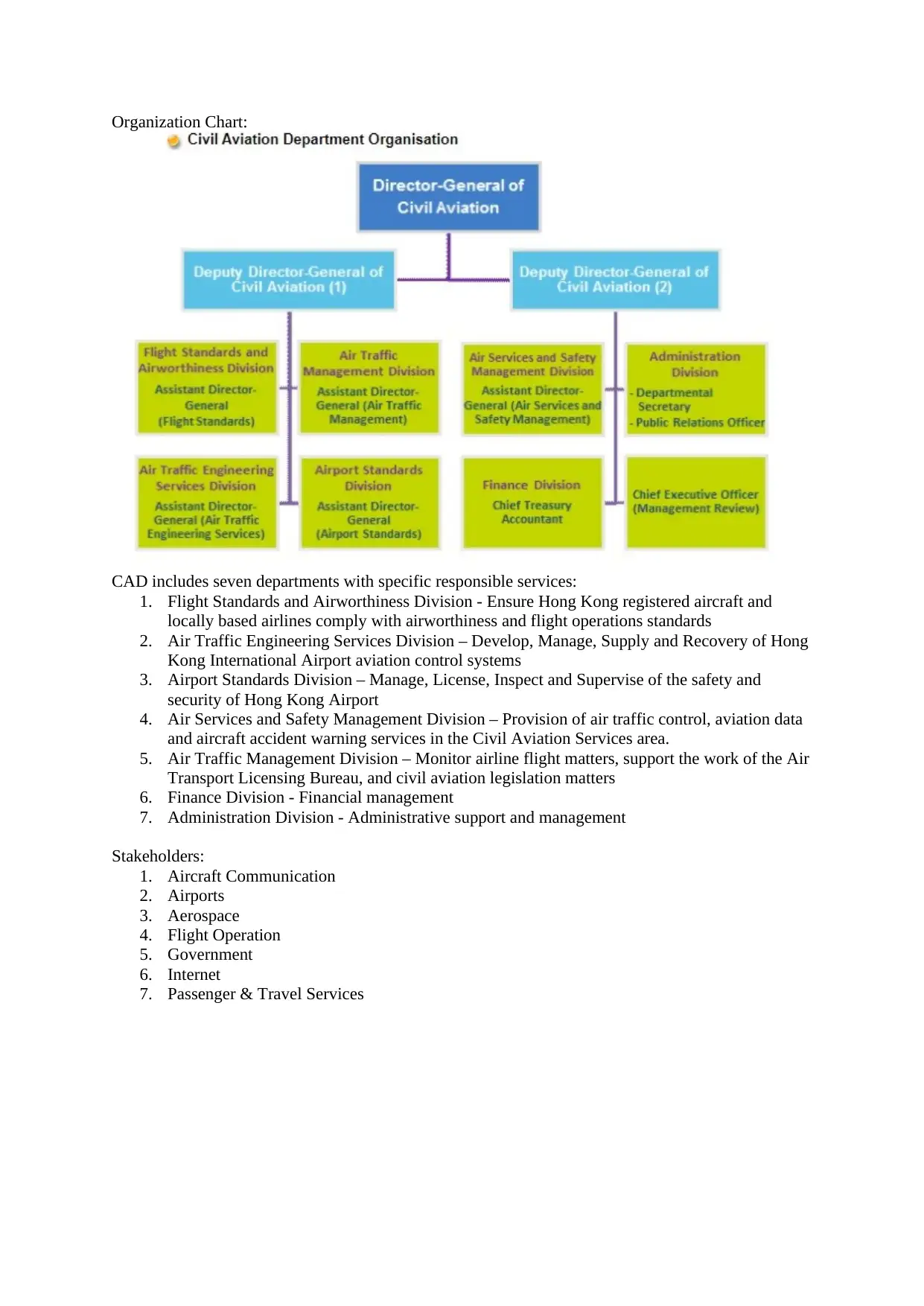
Organization Chart:
CAD includes seven departments with specific responsible services:
1. Flight Standards and Airworthiness Division - Ensure Hong Kong registered aircraft and
locally based airlines comply with airworthiness and flight operations standards
2. Air Traffic Engineering Services Division – Develop, Manage, Supply and Recovery of Hong
Kong International Airport aviation control systems
3. Airport Standards Division – Manage, License, Inspect and Supervise of the safety and
security of Hong Kong Airport
4. Air Services and Safety Management Division – Provision of air traffic control, aviation data
and aircraft accident warning services in the Civil Aviation Services area.
5. Air Traffic Management Division – Monitor airline flight matters, support the work of the Air
Transport Licensing Bureau, and civil aviation legislation matters
6. Finance Division - Financial management
7. Administration Division - Administrative support and management
Stakeholders:
1. Aircraft Communication
2. Airports
3. Aerospace
4. Flight Operation
5. Government
6. Internet
7. Passenger & Travel Services
CAD includes seven departments with specific responsible services:
1. Flight Standards and Airworthiness Division - Ensure Hong Kong registered aircraft and
locally based airlines comply with airworthiness and flight operations standards
2. Air Traffic Engineering Services Division – Develop, Manage, Supply and Recovery of Hong
Kong International Airport aviation control systems
3. Airport Standards Division – Manage, License, Inspect and Supervise of the safety and
security of Hong Kong Airport
4. Air Services and Safety Management Division – Provision of air traffic control, aviation data
and aircraft accident warning services in the Civil Aviation Services area.
5. Air Traffic Management Division – Monitor airline flight matters, support the work of the Air
Transport Licensing Bureau, and civil aviation legislation matters
6. Finance Division - Financial management
7. Administration Division - Administrative support and management
Stakeholders:
1. Aircraft Communication
2. Airports
3. Aerospace
4. Flight Operation
5. Government
6. Internet
7. Passenger & Travel Services
⊘ This is a preview!⊘
Do you want full access?
Subscribe today to unlock all pages.

Trusted by 1+ million students worldwide
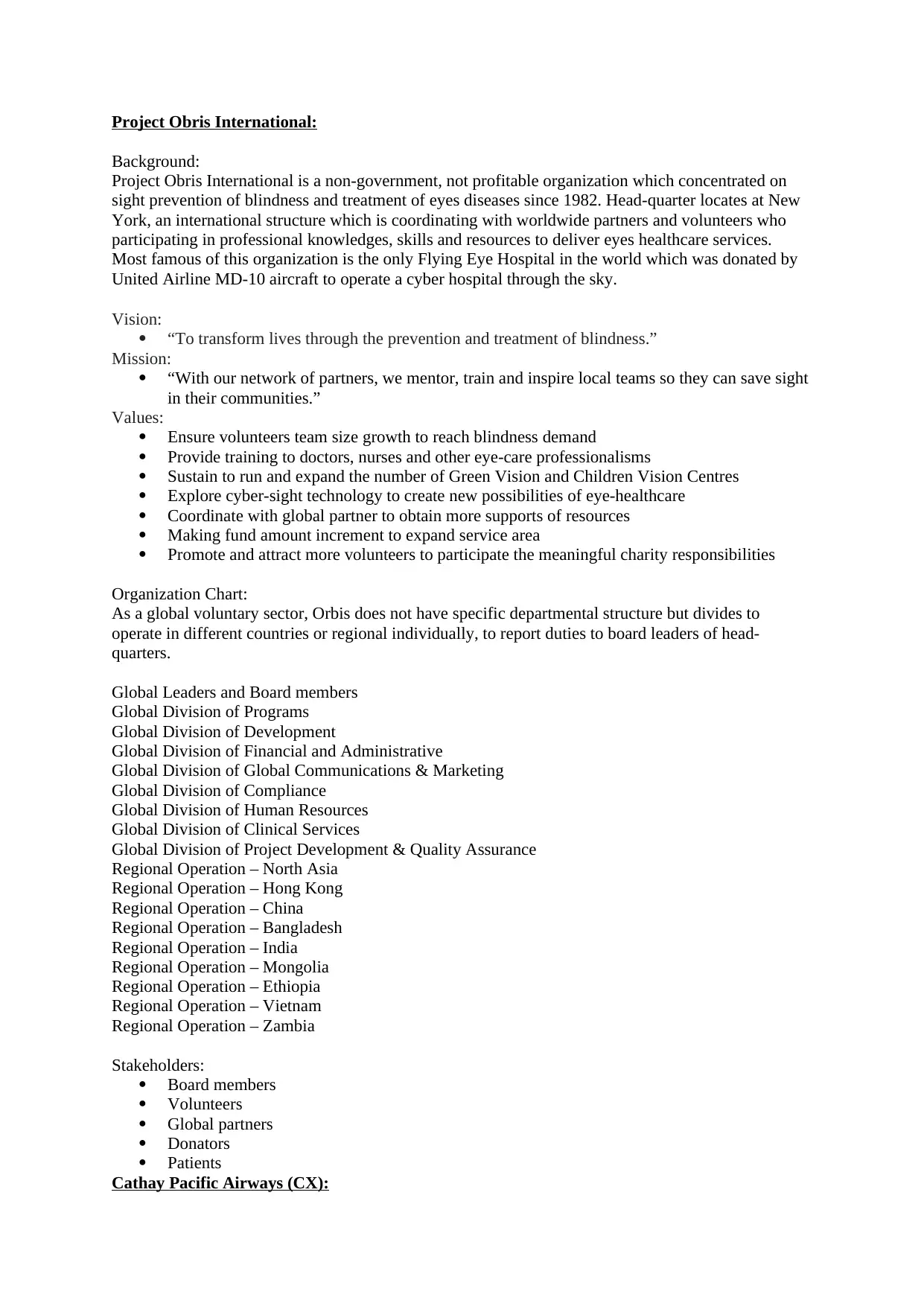
Project Obris International:
Background:
Project Obris International is a non-government, not profitable organization which concentrated on
sight prevention of blindness and treatment of eyes diseases since 1982. Head-quarter locates at New
York, an international structure which is coordinating with worldwide partners and volunteers who
participating in professional knowledges, skills and resources to deliver eyes healthcare services.
Most famous of this organization is the only Flying Eye Hospital in the world which was donated by
United Airline MD-10 aircraft to operate a cyber hospital through the sky.
Vision:
“To transform lives through the prevention and treatment of blindness.”
Mission:
“With our network of partners, we mentor, train and inspire local teams so they can save sight
in their communities.”
Values:
Ensure volunteers team size growth to reach blindness demand
Provide training to doctors, nurses and other eye-care professionalisms
Sustain to run and expand the number of Green Vision and Children Vision Centres
Explore cyber-sight technology to create new possibilities of eye-healthcare
Coordinate with global partner to obtain more supports of resources
Making fund amount increment to expand service area
Promote and attract more volunteers to participate the meaningful charity responsibilities
Organization Chart:
As a global voluntary sector, Orbis does not have specific departmental structure but divides to
operate in different countries or regional individually, to report duties to board leaders of head-
quarters.
Global Leaders and Board members
Global Division of Programs
Global Division of Development
Global Division of Financial and Administrative
Global Division of Global Communications & Marketing
Global Division of Compliance
Global Division of Human Resources
Global Division of Clinical Services
Global Division of Project Development & Quality Assurance
Regional Operation – North Asia
Regional Operation – Hong Kong
Regional Operation – China
Regional Operation – Bangladesh
Regional Operation – India
Regional Operation – Mongolia
Regional Operation – Ethiopia
Regional Operation – Vietnam
Regional Operation – Zambia
Stakeholders:
Board members
Volunteers
Global partners
Donators
Patients
Cathay Pacific Airways (CX):
Background:
Project Obris International is a non-government, not profitable organization which concentrated on
sight prevention of blindness and treatment of eyes diseases since 1982. Head-quarter locates at New
York, an international structure which is coordinating with worldwide partners and volunteers who
participating in professional knowledges, skills and resources to deliver eyes healthcare services.
Most famous of this organization is the only Flying Eye Hospital in the world which was donated by
United Airline MD-10 aircraft to operate a cyber hospital through the sky.
Vision:
“To transform lives through the prevention and treatment of blindness.”
Mission:
“With our network of partners, we mentor, train and inspire local teams so they can save sight
in their communities.”
Values:
Ensure volunteers team size growth to reach blindness demand
Provide training to doctors, nurses and other eye-care professionalisms
Sustain to run and expand the number of Green Vision and Children Vision Centres
Explore cyber-sight technology to create new possibilities of eye-healthcare
Coordinate with global partner to obtain more supports of resources
Making fund amount increment to expand service area
Promote and attract more volunteers to participate the meaningful charity responsibilities
Organization Chart:
As a global voluntary sector, Orbis does not have specific departmental structure but divides to
operate in different countries or regional individually, to report duties to board leaders of head-
quarters.
Global Leaders and Board members
Global Division of Programs
Global Division of Development
Global Division of Financial and Administrative
Global Division of Global Communications & Marketing
Global Division of Compliance
Global Division of Human Resources
Global Division of Clinical Services
Global Division of Project Development & Quality Assurance
Regional Operation – North Asia
Regional Operation – Hong Kong
Regional Operation – China
Regional Operation – Bangladesh
Regional Operation – India
Regional Operation – Mongolia
Regional Operation – Ethiopia
Regional Operation – Vietnam
Regional Operation – Zambia
Stakeholders:
Board members
Volunteers
Global partners
Donators
Patients
Cathay Pacific Airways (CX):
Paraphrase This Document
Need a fresh take? Get an instant paraphrase of this document with our AI Paraphraser
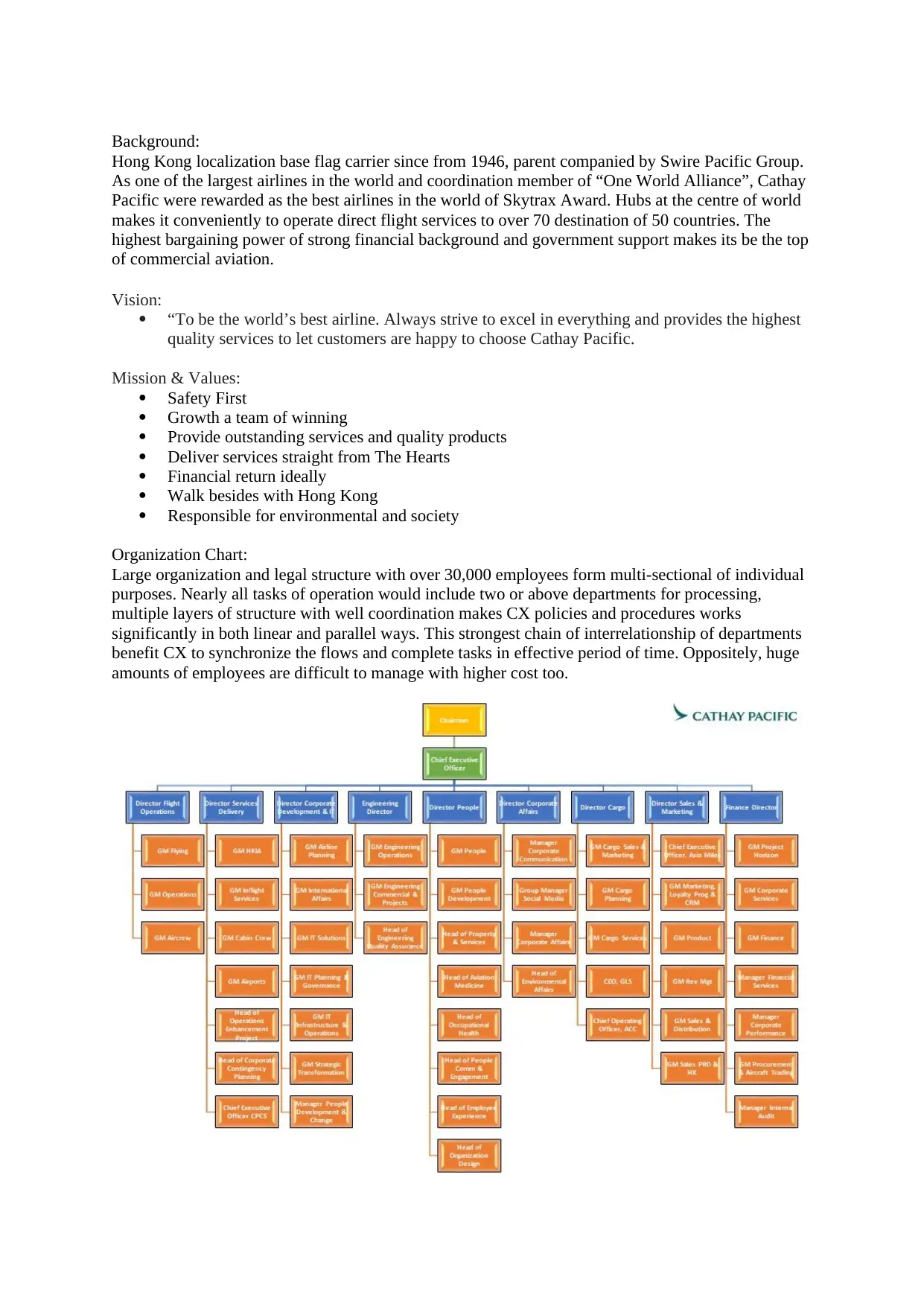
Background:
Hong Kong localization base flag carrier since from 1946, parent companied by Swire Pacific Group.
As one of the largest airlines in the world and coordination member of “One World Alliance”, Cathay
Pacific were rewarded as the best airlines in the world of Skytrax Award. Hubs at the centre of world
makes it conveniently to operate direct flight services to over 70 destination of 50 countries. The
highest bargaining power of strong financial background and government support makes its be the top
of commercial aviation.
Vision:
“To be the world’s best airline. Always strive to excel in everything and provides the highest
quality services to let customers are happy to choose Cathay Pacific.
Mission & Values:
Safety First
Growth a team of winning
Provide outstanding services and quality products
Deliver services straight from The Hearts
Financial return ideally
Walk besides with Hong Kong
Responsible for environmental and society
Organization Chart:
Large organization and legal structure with over 30,000 employees form multi-sectional of individual
purposes. Nearly all tasks of operation would include two or above departments for processing,
multiple layers of structure with well coordination makes CX policies and procedures works
significantly in both linear and parallel ways. This strongest chain of interrelationship of departments
benefit CX to synchronize the flows and complete tasks in effective period of time. Oppositely, huge
amounts of employees are difficult to manage with higher cost too.
Hong Kong localization base flag carrier since from 1946, parent companied by Swire Pacific Group.
As one of the largest airlines in the world and coordination member of “One World Alliance”, Cathay
Pacific were rewarded as the best airlines in the world of Skytrax Award. Hubs at the centre of world
makes it conveniently to operate direct flight services to over 70 destination of 50 countries. The
highest bargaining power of strong financial background and government support makes its be the top
of commercial aviation.
Vision:
“To be the world’s best airline. Always strive to excel in everything and provides the highest
quality services to let customers are happy to choose Cathay Pacific.
Mission & Values:
Safety First
Growth a team of winning
Provide outstanding services and quality products
Deliver services straight from The Hearts
Financial return ideally
Walk besides with Hong Kong
Responsible for environmental and society
Organization Chart:
Large organization and legal structure with over 30,000 employees form multi-sectional of individual
purposes. Nearly all tasks of operation would include two or above departments for processing,
multiple layers of structure with well coordination makes CX policies and procedures works
significantly in both linear and parallel ways. This strongest chain of interrelationship of departments
benefit CX to synchronize the flows and complete tasks in effective period of time. Oppositely, huge
amounts of employees are difficult to manage with higher cost too.

Key Stakeholders:
Government
Shareholders
Owner companies
Management Boards
Employees
Supplier and equipment manufacturers
Travel Agents
System providers
Passengers and customers
Government
Shareholders
Owner companies
Management Boards
Employees
Supplier and equipment manufacturers
Travel Agents
System providers
Passengers and customers
⊘ This is a preview!⊘
Do you want full access?
Subscribe today to unlock all pages.

Trusted by 1+ million students worldwide
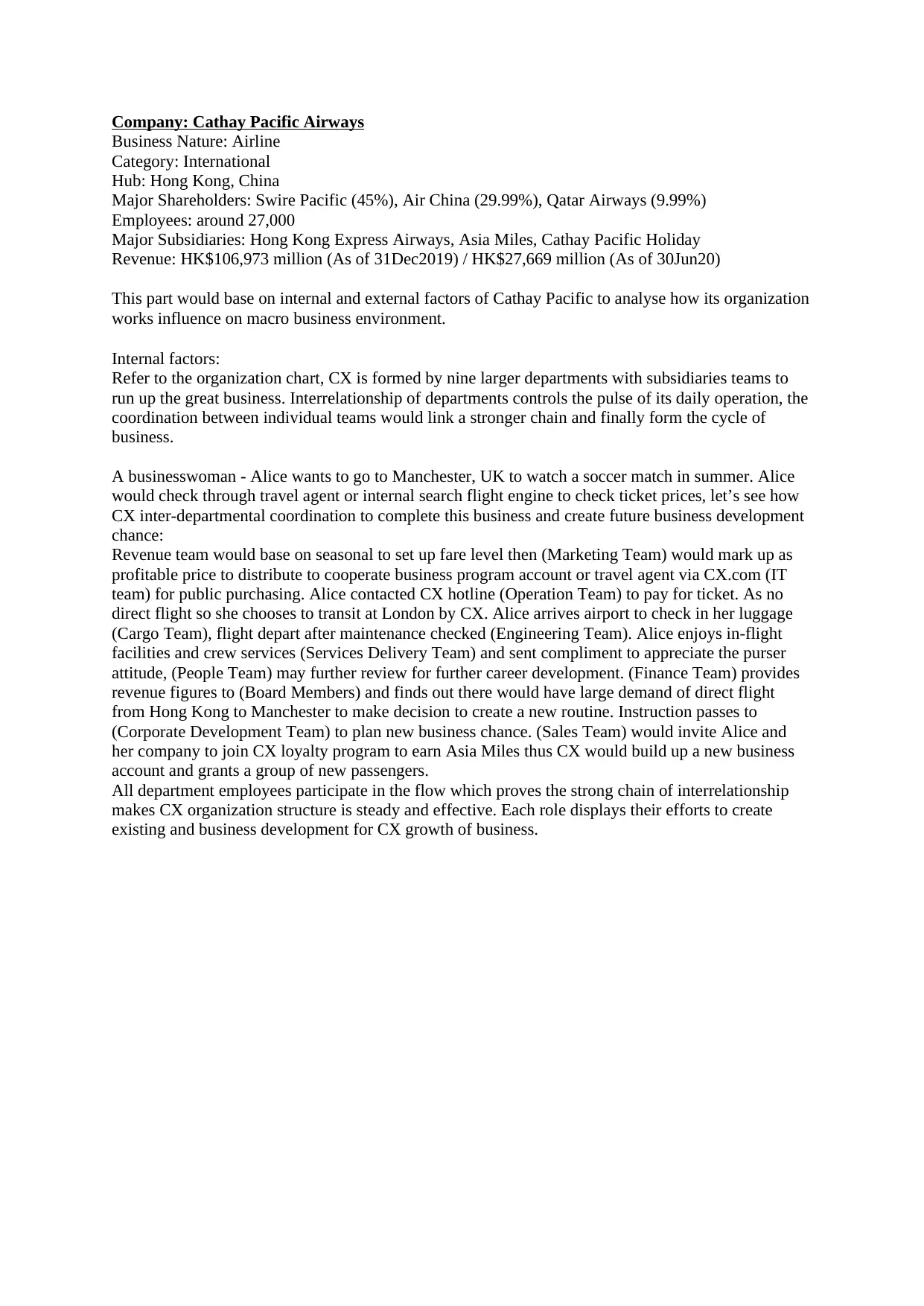
Company: Cathay Pacific Airways
Business Nature: Airline
Category: International
Hub: Hong Kong, China
Major Shareholders: Swire Pacific (45%), Air China (29.99%), Qatar Airways (9.99%)
Employees: around 27,000
Major Subsidiaries: Hong Kong Express Airways, Asia Miles, Cathay Pacific Holiday
Revenue: HK$106,973 million (As of 31Dec2019) / HK$27,669 million (As of 30Jun20)
This part would base on internal and external factors of Cathay Pacific to analyse how its organization
works influence on macro business environment.
Internal factors:
Refer to the organization chart, CX is formed by nine larger departments with subsidiaries teams to
run up the great business. Interrelationship of departments controls the pulse of its daily operation, the
coordination between individual teams would link a stronger chain and finally form the cycle of
business.
A businesswoman - Alice wants to go to Manchester, UK to watch a soccer match in summer. Alice
would check through travel agent or internal search flight engine to check ticket prices, let’s see how
CX inter-departmental coordination to complete this business and create future business development
chance:
Revenue team would base on seasonal to set up fare level then (Marketing Team) would mark up as
profitable price to distribute to cooperate business program account or travel agent via CX.com (IT
team) for public purchasing. Alice contacted CX hotline (Operation Team) to pay for ticket. As no
direct flight so she chooses to transit at London by CX. Alice arrives airport to check in her luggage
(Cargo Team), flight depart after maintenance checked (Engineering Team). Alice enjoys in-flight
facilities and crew services (Services Delivery Team) and sent compliment to appreciate the purser
attitude, (People Team) may further review for further career development. (Finance Team) provides
revenue figures to (Board Members) and finds out there would have large demand of direct flight
from Hong Kong to Manchester to make decision to create a new routine. Instruction passes to
(Corporate Development Team) to plan new business chance. (Sales Team) would invite Alice and
her company to join CX loyalty program to earn Asia Miles thus CX would build up a new business
account and grants a group of new passengers.
All department employees participate in the flow which proves the strong chain of interrelationship
makes CX organization structure is steady and effective. Each role displays their efforts to create
existing and business development for CX growth of business.
Business Nature: Airline
Category: International
Hub: Hong Kong, China
Major Shareholders: Swire Pacific (45%), Air China (29.99%), Qatar Airways (9.99%)
Employees: around 27,000
Major Subsidiaries: Hong Kong Express Airways, Asia Miles, Cathay Pacific Holiday
Revenue: HK$106,973 million (As of 31Dec2019) / HK$27,669 million (As of 30Jun20)
This part would base on internal and external factors of Cathay Pacific to analyse how its organization
works influence on macro business environment.
Internal factors:
Refer to the organization chart, CX is formed by nine larger departments with subsidiaries teams to
run up the great business. Interrelationship of departments controls the pulse of its daily operation, the
coordination between individual teams would link a stronger chain and finally form the cycle of
business.
A businesswoman - Alice wants to go to Manchester, UK to watch a soccer match in summer. Alice
would check through travel agent or internal search flight engine to check ticket prices, let’s see how
CX inter-departmental coordination to complete this business and create future business development
chance:
Revenue team would base on seasonal to set up fare level then (Marketing Team) would mark up as
profitable price to distribute to cooperate business program account or travel agent via CX.com (IT
team) for public purchasing. Alice contacted CX hotline (Operation Team) to pay for ticket. As no
direct flight so she chooses to transit at London by CX. Alice arrives airport to check in her luggage
(Cargo Team), flight depart after maintenance checked (Engineering Team). Alice enjoys in-flight
facilities and crew services (Services Delivery Team) and sent compliment to appreciate the purser
attitude, (People Team) may further review for further career development. (Finance Team) provides
revenue figures to (Board Members) and finds out there would have large demand of direct flight
from Hong Kong to Manchester to make decision to create a new routine. Instruction passes to
(Corporate Development Team) to plan new business chance. (Sales Team) would invite Alice and
her company to join CX loyalty program to earn Asia Miles thus CX would build up a new business
account and grants a group of new passengers.
All department employees participate in the flow which proves the strong chain of interrelationship
makes CX organization structure is steady and effective. Each role displays their efforts to create
existing and business development for CX growth of business.
Paraphrase This Document
Need a fresh take? Get an instant paraphrase of this document with our AI Paraphraser
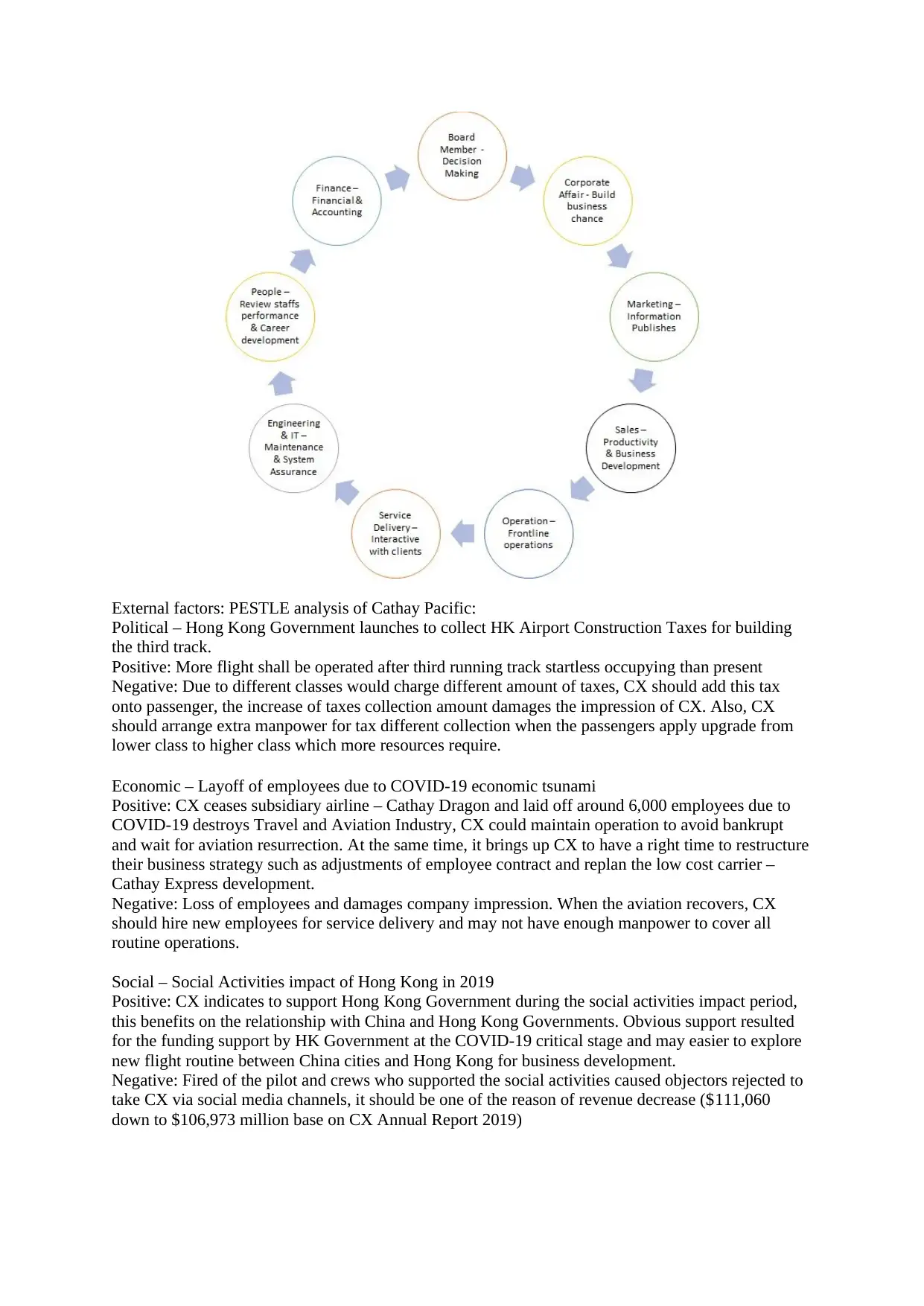
External factors: PESTLE analysis of Cathay Pacific:
Political – Hong Kong Government launches to collect HK Airport Construction Taxes for building
the third track.
Positive: More flight shall be operated after third running track startless occupying than present
Negative: Due to different classes would charge different amount of taxes, CX should add this tax
onto passenger, the increase of taxes collection amount damages the impression of CX. Also, CX
should arrange extra manpower for tax different collection when the passengers apply upgrade from
lower class to higher class which more resources require.
Economic – Layoff of employees due to COVID-19 economic tsunami
Positive: CX ceases subsidiary airline – Cathay Dragon and laid off around 6,000 employees due to
COVID-19 destroys Travel and Aviation Industry, CX could maintain operation to avoid bankrupt
and wait for aviation resurrection. At the same time, it brings up CX to have a right time to restructure
their business strategy such as adjustments of employee contract and replan the low cost carrier –
Cathay Express development.
Negative: Loss of employees and damages company impression. When the aviation recovers, CX
should hire new employees for service delivery and may not have enough manpower to cover all
routine operations.
Social – Social Activities impact of Hong Kong in 2019
Positive: CX indicates to support Hong Kong Government during the social activities impact period,
this benefits on the relationship with China and Hong Kong Governments. Obvious support resulted
for the funding support by HK Government at the COVID-19 critical stage and may easier to explore
new flight routine between China cities and Hong Kong for business development.
Negative: Fired of the pilot and crews who supported the social activities caused objectors rejected to
take CX via social media channels, it should be one of the reason of revenue decrease ($111,060
down to $106,973 million base on CX Annual Report 2019)
Political – Hong Kong Government launches to collect HK Airport Construction Taxes for building
the third track.
Positive: More flight shall be operated after third running track startless occupying than present
Negative: Due to different classes would charge different amount of taxes, CX should add this tax
onto passenger, the increase of taxes collection amount damages the impression of CX. Also, CX
should arrange extra manpower for tax different collection when the passengers apply upgrade from
lower class to higher class which more resources require.
Economic – Layoff of employees due to COVID-19 economic tsunami
Positive: CX ceases subsidiary airline – Cathay Dragon and laid off around 6,000 employees due to
COVID-19 destroys Travel and Aviation Industry, CX could maintain operation to avoid bankrupt
and wait for aviation resurrection. At the same time, it brings up CX to have a right time to restructure
their business strategy such as adjustments of employee contract and replan the low cost carrier –
Cathay Express development.
Negative: Loss of employees and damages company impression. When the aviation recovers, CX
should hire new employees for service delivery and may not have enough manpower to cover all
routine operations.
Social – Social Activities impact of Hong Kong in 2019
Positive: CX indicates to support Hong Kong Government during the social activities impact period,
this benefits on the relationship with China and Hong Kong Governments. Obvious support resulted
for the funding support by HK Government at the COVID-19 critical stage and may easier to explore
new flight routine between China cities and Hong Kong for business development.
Negative: Fired of the pilot and crews who supported the social activities caused objectors rejected to
take CX via social media channels, it should be one of the reason of revenue decrease ($111,060
down to $106,973 million base on CX Annual Report 2019)
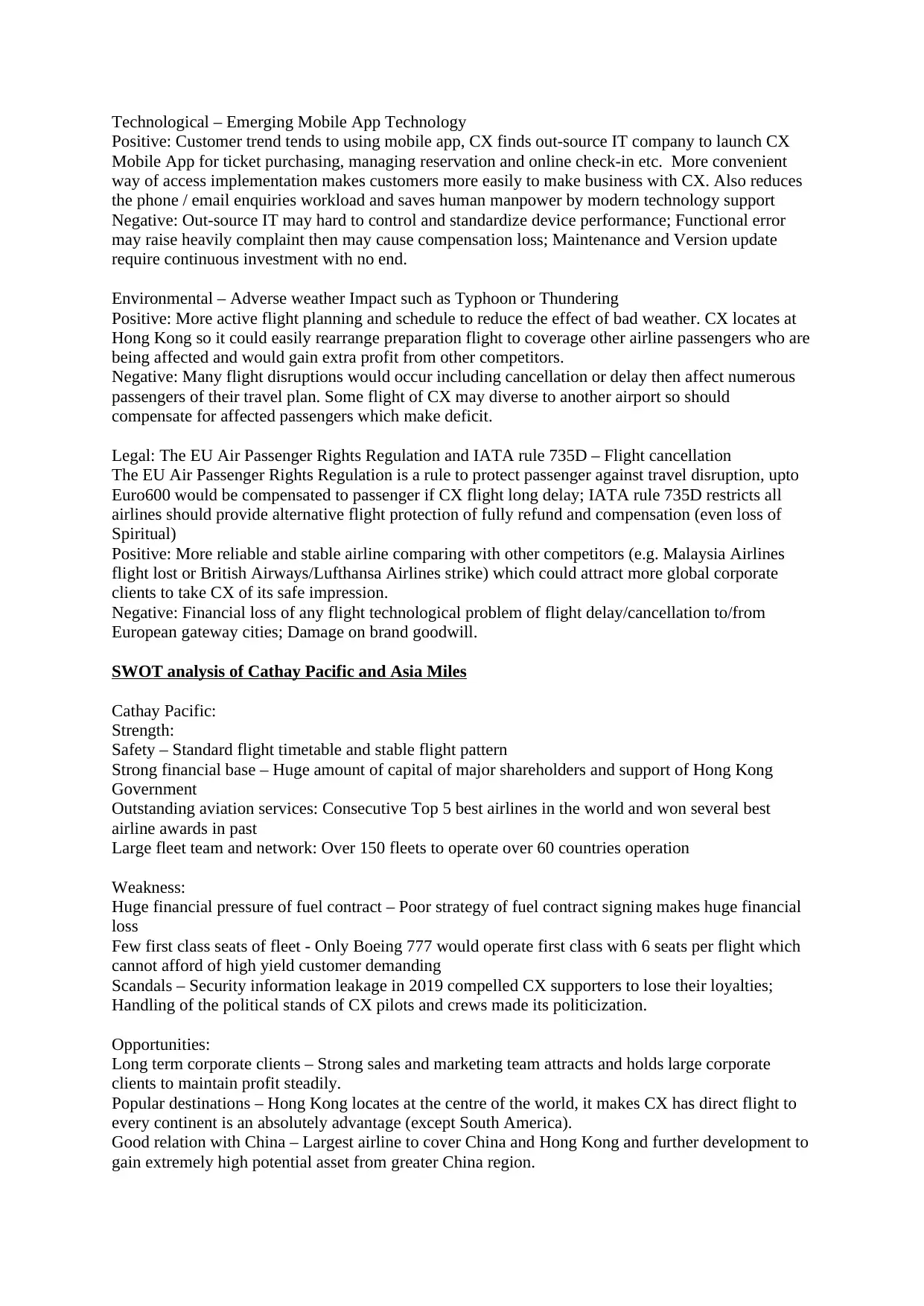
Technological – Emerging Mobile App Technology
Positive: Customer trend tends to using mobile app, CX finds out-source IT company to launch CX
Mobile App for ticket purchasing, managing reservation and online check-in etc. More convenient
way of access implementation makes customers more easily to make business with CX. Also reduces
the phone / email enquiries workload and saves human manpower by modern technology support
Negative: Out-source IT may hard to control and standardize device performance; Functional error
may raise heavily complaint then may cause compensation loss; Maintenance and Version update
require continuous investment with no end.
Environmental – Adverse weather Impact such as Typhoon or Thundering
Positive: More active flight planning and schedule to reduce the effect of bad weather. CX locates at
Hong Kong so it could easily rearrange preparation flight to coverage other airline passengers who are
being affected and would gain extra profit from other competitors.
Negative: Many flight disruptions would occur including cancellation or delay then affect numerous
passengers of their travel plan. Some flight of CX may diverse to another airport so should
compensate for affected passengers which make deficit.
Legal: The EU Air Passenger Rights Regulation and IATA rule 735D – Flight cancellation
The EU Air Passenger Rights Regulation is a rule to protect passenger against travel disruption, upto
Euro600 would be compensated to passenger if CX flight long delay; IATA rule 735D restricts all
airlines should provide alternative flight protection of fully refund and compensation (even loss of
Spiritual)
Positive: More reliable and stable airline comparing with other competitors (e.g. Malaysia Airlines
flight lost or British Airways/Lufthansa Airlines strike) which could attract more global corporate
clients to take CX of its safe impression.
Negative: Financial loss of any flight technological problem of flight delay/cancellation to/from
European gateway cities; Damage on brand goodwill.
SWOT analysis of Cathay Pacific and Asia Miles
Cathay Pacific:
Strength:
Safety – Standard flight timetable and stable flight pattern
Strong financial base – Huge amount of capital of major shareholders and support of Hong Kong
Government
Outstanding aviation services: Consecutive Top 5 best airlines in the world and won several best
airline awards in past
Large fleet team and network: Over 150 fleets to operate over 60 countries operation
Weakness:
Huge financial pressure of fuel contract – Poor strategy of fuel contract signing makes huge financial
loss
Few first class seats of fleet - Only Boeing 777 would operate first class with 6 seats per flight which
cannot afford of high yield customer demanding
Scandals – Security information leakage in 2019 compelled CX supporters to lose their loyalties;
Handling of the political stands of CX pilots and crews made its politicization.
Opportunities:
Long term corporate clients – Strong sales and marketing team attracts and holds large corporate
clients to maintain profit steadily.
Popular destinations – Hong Kong locates at the centre of the world, it makes CX has direct flight to
every continent is an absolutely advantage (except South America).
Good relation with China – Largest airline to cover China and Hong Kong and further development to
gain extremely high potential asset from greater China region.
Positive: Customer trend tends to using mobile app, CX finds out-source IT company to launch CX
Mobile App for ticket purchasing, managing reservation and online check-in etc. More convenient
way of access implementation makes customers more easily to make business with CX. Also reduces
the phone / email enquiries workload and saves human manpower by modern technology support
Negative: Out-source IT may hard to control and standardize device performance; Functional error
may raise heavily complaint then may cause compensation loss; Maintenance and Version update
require continuous investment with no end.
Environmental – Adverse weather Impact such as Typhoon or Thundering
Positive: More active flight planning and schedule to reduce the effect of bad weather. CX locates at
Hong Kong so it could easily rearrange preparation flight to coverage other airline passengers who are
being affected and would gain extra profit from other competitors.
Negative: Many flight disruptions would occur including cancellation or delay then affect numerous
passengers of their travel plan. Some flight of CX may diverse to another airport so should
compensate for affected passengers which make deficit.
Legal: The EU Air Passenger Rights Regulation and IATA rule 735D – Flight cancellation
The EU Air Passenger Rights Regulation is a rule to protect passenger against travel disruption, upto
Euro600 would be compensated to passenger if CX flight long delay; IATA rule 735D restricts all
airlines should provide alternative flight protection of fully refund and compensation (even loss of
Spiritual)
Positive: More reliable and stable airline comparing with other competitors (e.g. Malaysia Airlines
flight lost or British Airways/Lufthansa Airlines strike) which could attract more global corporate
clients to take CX of its safe impression.
Negative: Financial loss of any flight technological problem of flight delay/cancellation to/from
European gateway cities; Damage on brand goodwill.
SWOT analysis of Cathay Pacific and Asia Miles
Cathay Pacific:
Strength:
Safety – Standard flight timetable and stable flight pattern
Strong financial base – Huge amount of capital of major shareholders and support of Hong Kong
Government
Outstanding aviation services: Consecutive Top 5 best airlines in the world and won several best
airline awards in past
Large fleet team and network: Over 150 fleets to operate over 60 countries operation
Weakness:
Huge financial pressure of fuel contract – Poor strategy of fuel contract signing makes huge financial
loss
Few first class seats of fleet - Only Boeing 777 would operate first class with 6 seats per flight which
cannot afford of high yield customer demanding
Scandals – Security information leakage in 2019 compelled CX supporters to lose their loyalties;
Handling of the political stands of CX pilots and crews made its politicization.
Opportunities:
Long term corporate clients – Strong sales and marketing team attracts and holds large corporate
clients to maintain profit steadily.
Popular destinations – Hong Kong locates at the centre of the world, it makes CX has direct flight to
every continent is an absolutely advantage (except South America).
Good relation with China – Largest airline to cover China and Hong Kong and further development to
gain extremely high potential asset from greater China region.
⊘ This is a preview!⊘
Do you want full access?
Subscribe today to unlock all pages.

Trusted by 1+ million students worldwide
1 out of 16
Related Documents
Your All-in-One AI-Powered Toolkit for Academic Success.
+13062052269
info@desklib.com
Available 24*7 on WhatsApp / Email
![[object Object]](/_next/static/media/star-bottom.7253800d.svg)
Unlock your academic potential
Copyright © 2020–2025 A2Z Services. All Rights Reserved. Developed and managed by ZUCOL.

![Business and Business Environment Analysis Report - [Course Name]](/_next/image/?url=https%3A%2F%2Fdesklib.com%2Fmedia%2Fimages%2Fsh%2F1f2b172c364e48c8beb7aaca2d402a17.jpg&w=256&q=75)



